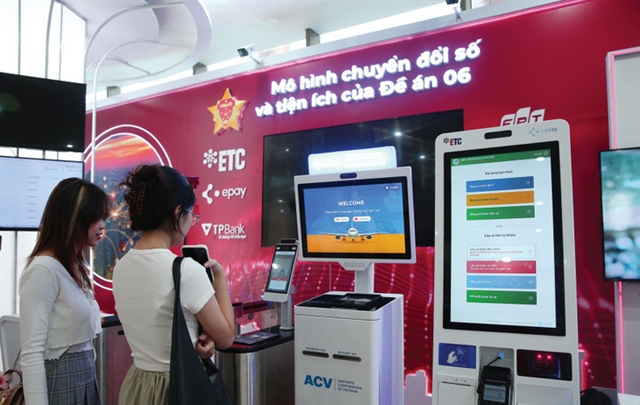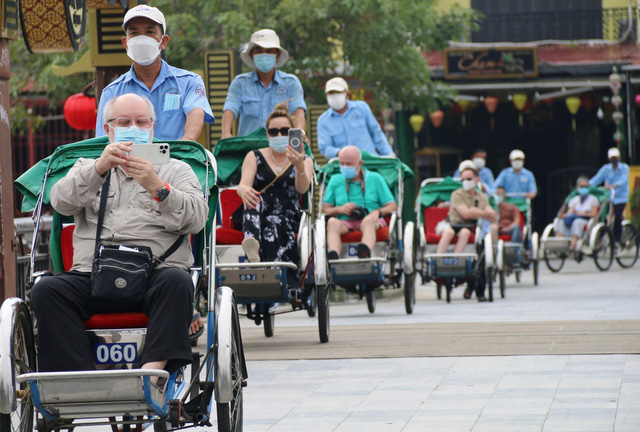 Business Beat
Business Beat


|
| Foreign travellers visit Hội An Ancient Town. Quảng Nam Province. Photo chinhphu.vn |
Compiled by Thiên Lý
The stocks of several tourism companies like Vietourist, Hospitality & Service Joint Stock Company and Hoàng Kim Tây Nguyên Group Joint Stock Company have been gaining for more than a month to average increases of 20-30 per cent.
Two major tourism companies, Vietravel and TTC Tourist, have said they made profit in the last quarter of 2021 after several quarters of big losses.
Hospitality companies have also seen their share prices rise.
In the last three months, the price of CEO shares has risen by 80 per cent.
Shares of resort property companies like FLT Group Ltd. and Vinhud have made gains of 10-50 per cent since the beginning of the year.
Stock market insiders said the shares of many businesses in the tourism and hospitality sectors have regained their attraction after a long slump due to the COVID-19 pandemic.
Their operations have recovered significantly, especially after the Government came out with important decisions that have had a strong impact on the travel and hospitality sectors.
One of them was to fully restart inbound tourism activities on March 15 after two years of Covid-triggered border closures.
Earlier the resumption of international flights on Feb. 23 and an agreement on the need to accelerate the reopening of the border in a safe manner to revive the tourism industry post the pandemic made at the seventh ASEAN Economic Community (AEC) Dialogue on Feb.17 were also catalysts that encouraged tourism companies and persuaded investors to take a fresh look at tourism and tourist services stocks.
Conditions for a stunning recovery
Analysts said that the tourism sector is in a good position to make a strong recovery.
According to data from Fiinpro, tourism and entertainment were among the three poorest performing sectors on the stock market in 2021, gaining a 6.3 per cent compared to a nearly 36 per cent rise in the benchmark VN-Index.
But things are expected to improve significantly this year as figures from the Việt Nam National Administration of Tourism and analyses from market research players like Savills shows.
For instance, the nine-day Lunar New Year holidays saw 6.1 million domestic tourists who spent an estimated VNĐ25 trillion (US$1.09 billion).
A recent survey of some travel companies found that 80 per cent of their tours are fully booked until April 30.
Analytical data from Google Destination Insights showed that the number of international searches for aviation and tourism information about Việt Nam skyrocketed in December 2021 and remained at a very high level.
On January 21 they were 425 per cent higher than a year earlier when the pandemic was raging.
Analysts from Yuanta Securities Việt Nam and FPT Securities Joint Stock Company said the recent increase in tourist numbers would bolster revenues and profits of travel firms, making their shares attractive.
Their efforts to cut costs and accelerate digital transformation of their marketing and sales activities have also contributed to improving their profits, they pointed out.
Vietravel has simplified its management to optimise operations and save fixed costs and train staff in the use of digital technologies to easily access potential customers and explore opportunities for development.
According to a report by Savills Việt Nam in early March, the number of hotel and resort projects has grown at an impressive rate from 36 projects with 8,200 rooms in 2021 to 120 with 32,000 rooms by January this year.
They are not only in popular tourist destinations localities like HCM City, Hà Nội, Nha Trang, Đà Nẵng, and Phú Quốc but also many other cities and provinces like Bà Rịa- Vũng Tàu, Đà Lạt, Phan Thiết, and Quy Nhơn.
This has helped increased the options available to foreign and domestic tourists.
Savills’ report also said that 64 international hotel brands operate in Việt Nam and have tie-ups with local companies, enabling the latter to get more guests, especially from abroad.
For instance, Vinpearl Joint Stock Company and the award-winning global company Meliá Hotels International announced a tie-up in Feb. that promises to offer both domestic and international tourists the opportunity to experience top-notch accommodation and services.
This collaboration is also expected to provide Vinpearl with easier access to Melia Hotels’ global customer base, experts said.
The Ministry of Culture, Sports and Tourism targets 8-9 million international arrivals a year in 2022 and 2023 and 65-70 million domestic tourists, increasing to 18 million and 85 million by 2026.
Speaking about those targets, experts said the country’s successful vaccination campaign and the removal of restrictions on international flights should enable Việt Nam to fully reopen to tourism and grab opportunities, which would also provide impetus to its economic recovery.
While the targets look ambitious they are eminently reachable, they added.
Textile and garment: challenges continue
Domestic textile and garment firms have been warned that despite steady orders they will face a host of challenges this year like shortages of inputs and human resources and rising logistics costs.
For instance, logistics costs have risen three-fold from the average figure of the last five years.
These impacts of the COVID-19 pandemic have caused a massive labour shortage and disrupted supply chains.
An even bigger factor is the increasingly fierce competition the textile and garment industry has to face from major rivals China, India and Bangladesh.
In the event, the Vietnam Textile and Apparel Association (VITAS) has three growth scenarios with different targets for this year.
The most optimistic will see export of US$42.5-43.5 billion if the pandemic continues to be controlled well.
The second envisages exports of US$40-41 billion if the Covid crisis ends in the second quarter.
Exports will only reach $38-39 billion if the disease continues until the end of the year.
Last year, despite the Covid-19 pandemic, exports were worth $39 billion, an increase of 11.2 per cent from 2020. VNS




